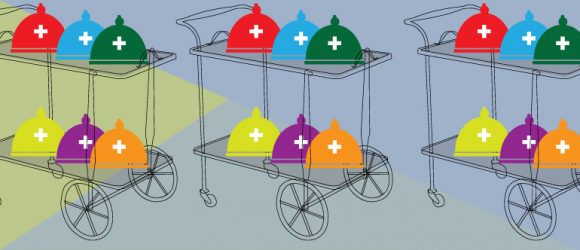Let’s Be Clear, Size Matters: On Marketing Narrow Networks


Insurers and hospitals, how often have you heard this: “You didn’t tell me my provider (or preferred facility or selected treatment) wasn’t covered by my health plan”? It’s a frustrating situation not only for payers and providers but also for consumers who can feel frantic about the confusion and may even feel – are you ready for this? – duped. Even when you’ve explained the rules of the road, consumers don’t always understand the benefits and limitations of the provider networks associated with their health plans.
In addition to its importance in meeting patient health needs, a network’s size matters a great deal in terms of consumer satisfaction. Are consumers getting what they signed up for? Are they getting what they think they signed up for? The two can be very different: actual plan benefits and limitations vs. perceived plan benefits and limitations. This can lead to accusations of “bait and switch,” often the result of “surprises” at the point of care, such as when a patient is trying to make an appointment with a specific doctor or to utilize a particular hospital facility. In most cases, this happens when consumers fail to read plan descriptions thoroughly.
So is there anything to do from a marketing perspective? Yes: When it comes to clarity, you may want to consider erring on the side of overkill. And in some cases, you may want to lead with – or at least emphasize – the limitations.
Let us show you what we mean by breaking it down for payers and providers:
Payers
There are a lot of headlines right now about lawsuits concerning narrow networks. These include recent lawsuits in California that have called into question the adequacy of some narrow networks (specifically those on the healthcare exchange). In some cases, these allege that specific health plans actually misled consumers. But even when these two extremes – inadequacy and deception – aren’t factors (they are only rarely), it goes without saying that narrow networks of any variety and under all circumstances require health plans to be totally forthcoming.
And while consumers must do their part to select coverage that matches their needs, health plans can provide customer education materials at many points of access (not only including websites and exchanges but also customer service call centers) in language that is simple, clear and easy to understand.
This can be especially important in marketing narrow networks, which are becoming more popular. In fact, they represent approximately half of the plans offered on healthcare exchanges. The primary benefit of narrow networks, of course, is that they can be less expensive. That can be desirable for both the health plan and its customers. According to reports, narrow networks can lower spending by a third, which means that as long as consumers are clear about their limited coverage, they can work quite well. They can also be quite popular, as evidenced by shopper preferences on the healthcare exchanges. According to one study, for example, of those consumers who enrolled via ACA and knew which kind of network was included with the plan they chose, 42 percent reported selecting a plan with a narrow network.
However, since they do involve certain trade-offs for the customer, customers must be provided with every detail they’ll need to make informed decisions. Narrow networks aren’t for everyone, and it’s ok – even optimal – to point that out in your own version of “buyer beware” to consumers. Help customers weigh the benefits and trade-offs as they choose plans… every step of the way. The ability to comparison shop – among different insurers and among different plans offered by a single insurer – is not only a main premise of the ACA marketplaces but also the direction the entire industry is headed.
Consider detailing several cost scenarios: some in which the customer pays to see out-of-network providers; others in which the customer pays a higher premium and has fewer out-of-pocket expenses. Consider offering self-assessment tools prompting a series of responses that can determine “Is a narrow network right for me?” or other variations on the question. Consider mentioning network size in your tips for choosing plans, in your how-to’s for sorting through benefits and in your website’s FAQs. In other words, there’s no such thing as too much clarity in too many places when it comes to customer education.
Providers
For providers, the networks come into play for marketing in a couple of different ways. The first angle is similar to the challenges faced by health plans: clear and effective communication around participation in health plans. When consumers want to know what health insurance your hospital or provider practice accepts for payment, they don’t want to hear, “It’s complicated” (even though it is). Different departments may handle insurance in different ways. Not all doctors accept the same plans. And to make matters worse, there are many plan levels (silver, gold and platinum, for example) within each health insurance brand: Which services are covered by which plans?
As daunting as it is, it’s partly the job of hospital marketing to bring clarity to the issue by advancing patient awareness and education. However, emphasis must be placed on patient involvement and participation, as well, and hospitals must be willing to help consumers with inquiries to their health plans.
The second angle is less about customer education and more about differentiating your hospital or health system in the marketplace. Are you the only (or one of the only) provider networks covered by a particular plan? Here, the limitations of a narrow network are actually to your advantage; you are an “exclusive” provider. But even when you’re not, as competition for healthcare consumers gets more intense, it’s not hard to imagine a need for persuading consumers to choose plans that include you.
Does this mean we’re likely to start seeing hospitals marketing themselves alongside health plans during open enrollment? It’s rare now, but as networks narrow – and consumers base their decisions on the providers and hospitals that are covered – we may see more of it. In addition, as providers have more of a vested interest in consumers choosing plans that include them, it will be interesting to see if more partner or co-brand marketing emerges.
Takeaway
Marketing materials (and well-trained customer service representatives) can help both health plans and hospitals make full and accurate disclosures to consumers. Wonder if you’re being clear enough at all points of customer contact? Is your approach not only helpful but also strategic as it positions you in the marketplace, either with how you sell your own product options or versus your competitors? Let’s look at your marketing program together and figure it out.









